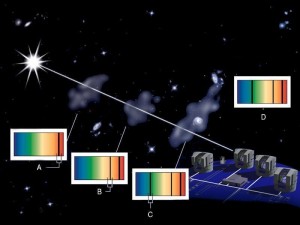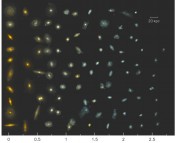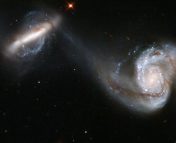TITLE: A Survey of Mg II Absorption at 2 < z < 6 with Magellan/FIRE I: Sample and Evolution of the Mg II Frequency
AUTHORS: Mike Matejek, Rob Simcoe
FIRST AUTHOR’S INSTITUTION: MIT Kavli Center
When the light from a distant quasar finally arrives at Earth, it often carries far more information than it did when it was emitted – the shadows of gas and galaxies that have intervened over the cosmic distances between us and the source. These features can tell us how the universe evolves in both space and time, by allowing us to sample both low and high redshifts for structures that would not otherwise be visible. The ion Mg II in particular has long been used as a tracer of cold, metal-rich gas around galaxies, an important clue in the context of galaxy and star formation. This paper uses a new IR spectrograph, FIRE, deployed on the Magellan 6.5 m telescopes, to present the first high-redshift sample of Mg II systems, including the most distant Mg II system yet found (z = 5.33). The authors show that the number of strong Mg II systems appears to peak and decline in number along with the star formation history of the universe, suggesting a correlation between the two, while weak Mg II systems stay mysteriously constant.

The process by which absorption lines are printed onto the spectrum of a distant background object. The quasar (sunburst) emits light towards Earth, but intervening clouds of gas imprint different absorption lines (A, B, and C) on its spectrum along the way. (Image from http://www.hs.uni-hamburg.de).
Finding something like a gas cloud that absorbs light rather than emitting it is tricky. To do so, astronomers use a sightline – an observation of a faraway, bright background object with a known, mostly smooth spectrum. Any object placed between the distant background and Earth will cast a shadow in that sightline, usually in the form of an absorption line. Think of it like watching a lightbulb down a distant hallway and observing the shadows cast by people walking between you and the light. The “lightbulbs” traditionally used in these surveys are quasars, the active supermassive black holes at the centers of distant galaxies. Quasars are pointlike, very bright (meaning they can be seen from far away), and have relatively smooth continuum-like spectra with a few strong emission features.
The Mg II absorption doublet at 2796/2803 A is a favorite absorption feature for this type of work, for several reasons: one, the doublet has a fixed spacing and ratio of line strengths (the amount the line dips below continuum), making it easy to identify in a quasar sightline and hence to calculate the redshift of the gas; and two, it is a reliable tracer of cold, metal-rich gas, meaning gas that has been cycled through stars at least once and therefore likely to be associated with a galaxy, rather than simply present in the intergalactic medium. However, the problem lies in the rest-frame wavelength of the doublet. Mg II is only visible in the optical band at redshifts lower than roughly z = 2. Any further back, and the doublet is redshifted down into the near-IR, a band that is difficult to observe in from ground-based telescopes because of the strong emission and absorption from Earth’s own atmosphere. The FIRE spectrograph was specifically designed to overcome these problems, and can search for Mg II to z ~ 5.5 and beyond.

A sample of six Mg II absorption features from this paper. Some features are highly complex, showing multiple gas clouds with distinct velocities. (Image from paper).
The authors use FIRE to take spectra of 46 high-redshift (z = 3.55 – 6.28) quasars chosen from the SDSS and search those spectra for absorption lines. Because each intervening object will absorb light at its specific redshift, there can be many duplicates of the same absorption line embedded at different points in a single sightline, representing the same frequency of light redshifted by varying amounts. In the end these 46 sightlines yielded 111 Mg II systems – each of which, in theory, corresponds to a giant cloud of intergalactic gas – an impressive sample, including five systems with z > 5.
With such a large sample, the authors can look at the evolution of the number density of absorbers over a significant fraction of cosmic time. If Mg II traces star formation, it should evolve with the star formation rate – i.e., there should be more absorbers when star formation is higher. By now it’s generally accepted that the overall star formation rate of the universe peaked around z = 2 – 3. Therefore, if Mg II outflows really do trace star formation, we should see a corresponding peak in the number of Mg II systems at these redshifts. If, on the other hand, it traces other processes such as halo assembly, the evolution will be different.

The evolution of the number density of Mg II systems. The top two panels show weaker absorbers, whose evolution is consistent with a steady population. The bottom panel, by contrast, shows a significant evolution in the number density of strong absorbers. Circles represent data from this survey, triangles from Nestor 2005 and squares from Prochter 2006. (Image from this paper).
In the end, the authors find that the evolution of Mg II splits into two distinct populations. The strength of absorption lines is characterized by their equivalent width, a measure of the total light absorbed by the line. The authors divide the population into the weak absorbers, with an equivalent width W < 1 A, and the strong absorbers, with W > 1 A. The number density of weak absorbers over time is consistent with no evolution – the proportion stays roughly fixed. But the number density of strong absorbers triples going back to z = 3, and declines thereafter. This suggests a correlation between strong Mg II absorption and star formation, bolstering support for the model of Mg II as a tracer of galactic outflows. These winds, powered by newly-formed stars, carry lots of dense, fresh metal-enriched gas, and so we expect them to be strong absorbers. By contrast, models that describe Mg II as a component of cold dark matter (CDM) haloes rather than as a product of star formation predict that the number density should be much lower at high redshifts than is observed. The weak absorbers, however, diverge from the strong population, and stay roughly constant in time. This suggests that those weak absorbers may trace a different physical process than the strong ones, one that we haven’t yet pinned down.
Mg II has great potential to trace key galactic formation processes across cosmic time. The difficulty of looking back increases as we probe to higher redshifts, and surveys that look for absorption line systems – far easier to distinguish than individual galaxies – are important in our understanding of the early history of galaxy and star formation. With the opening of higher redshift regimes, we can look back even farther in time.





Trackbacks/Pingbacks